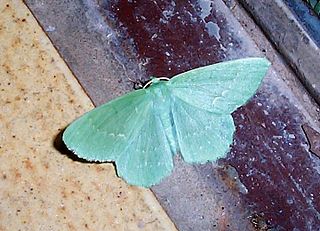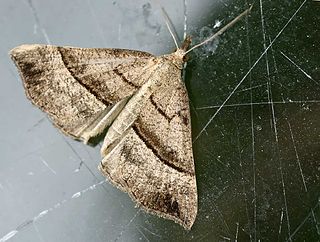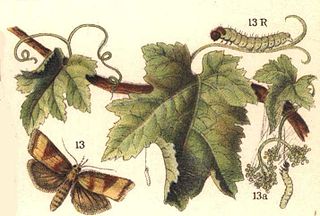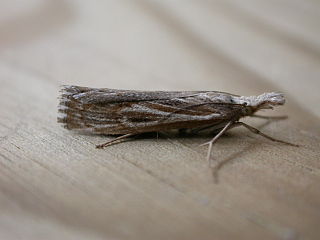
Aster is a genus of perennial flowering plants in the family Asteraceae. Its circumscription has been narrowed, and it now encompasses around 180 species, all but one of which are restricted to Eurasia; many species formerly in Aster are now in other genera of the tribe Astereae. Aster amellus is the type species of the genus and the family Asteraceae.

The Pterophoridae or plume moths are a family of Lepidoptera with unusually modified wings. Though they belong to the Apoditrysia like the larger moths and the butterflies, unlike these they are tiny and were formerly included among the assemblage called "microlepidoptera".

The Elachistidae are a family of small moths in the superfamily Gelechioidea. Some authors lump about 3,300 species in eight subfamilies here, but this arrangement almost certainly results in a massively paraphyletic and completely unnatural assemblage, united merely by symplesiomorphies retained from the first gelechioid moths.

Galium is a large genus of annual and perennial herbaceous plants in the family Rubiaceae, occurring in the temperate zones of both the Northern and Southern Hemispheres. Some species are informally known as bedstraw.

The Geometroidea are the superfamily of geometrid moths in the order Lepidoptera. It includes the families Geometridae, Uraniidae, Epicopeiidae, Sematuridae, and the recently established family Pseudobistonidae. The monotypic genus Apoprogones was considered a separate geometroid family of the Apoprogonidae by a minority, but is now subsumed under the Sematuridae.
Cyclotorna is a genus of moths, the sole one of family Cyclotornidae, with five recognized species, all endemic to Australia. This family and the closely related Epipyropidae are unique among the Lepidoptera in that the larvae are ectoparasites, the hosts in this case typically being leafhoppers, sometimes scale insects. The larvae of cyclotornids, however, leave the hemipteran host and become predatory on the brood in ant nests, apparently using chemical cues to induce the ants to carry the larvae into the ant nest.

The Epipyropidae comprise a small family of moths. This family and the closely related Cyclotornidae are unique among the Lepidoptera in that the larvae are ectoparasites, the hosts typically being fulgoroid planthoppers, thus the common name planthopper parasite moths.

The Batrachedridae are a small family of moths. These are small, slender moths which rest with their wings wrapped tightly around their bodies. The taxonomy of this and related groups is often disputed. It was long thought to contain two genera, Batrachedra and Houdinia.

The Hypeninae are a subfamily of moths in the family Erebidae. A notable species is Mecistoptera griseifusa, which lives solely on tears it drinks with its proboscis.
Lypusidae is an obscure family of moths placed in the superfamily Gelechioidea.

The Lecithoceridae, or long-horned moths, are a family of small moths described by Simon Le Marchand in 1947. Although lecithocerids are found throughout the world, the great majority are found in the Indomalaya ecozone and the southern part of the Palaearctic ecozone.
Andesiana is a genus representing its own family Andesianidae and superfamily Andesianoidea, the "Andean endemic moths". It contains three species with a wingspan up to 5.4 cm. in female A. similis and 3.5 cm. in males. This far surpasses in size any previously known monotrysian moth. These large Microlepidoptera are restricted to Andean South America, from where they were described originally in 1989 in the family Cossidae by their discoverer Patricia Gentili.

The Sparganothini are a tribe of tortrix moths.

Pediasia is a genus of small moths in the family Crambidae. They are widespread across temperate Eurasia and adjacent regions.
Orthocomotis is a genus of moths belonging to the family Tortricidae.

Cnephasia is a genus of tortrix moths. It belongs to the subfamily Tortricinae and therein to the tribe Cnephasiini, of which it is the type genus.

Depressaria is a moth genus of the superfamily Gelechioidea. It is the type genus of subfamily Depressariinae, which is often – particularly in older treatments – considered a distinct family Depressariidae or included in the Elachistidae, but actually seems to belong in the Oecophoridae.

Autosticha is a genus of gelechioid moths. It belongs to the subfamily Autostichinae, which is either placed in the concealer moth family (Oecophoridae), or in an expanded Autostichidae. It is the type genus of its subfamily. Originally, this genus was named Automola, but this name properly refers to a fly genus in family Richardiidae.

The Stenomatinae are a subfamily of small moths in the family Depressariidae.

















